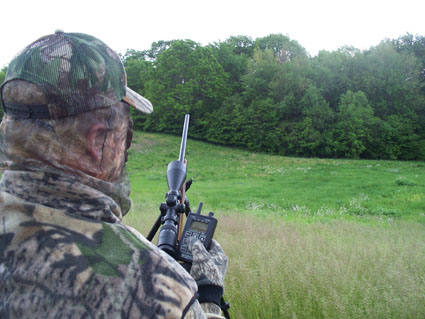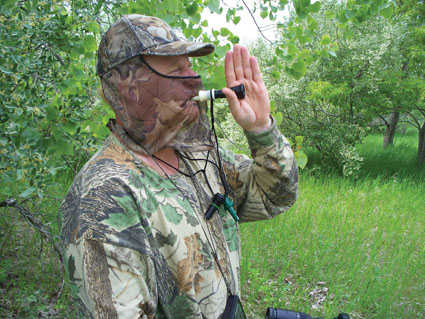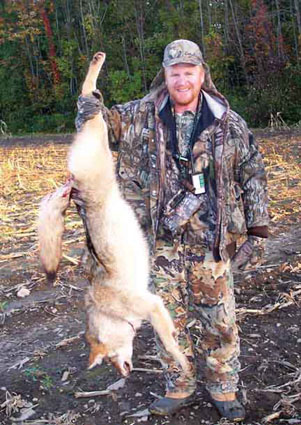 The Early Bird Gets The Coyote?
The Early Bird Gets The Coyote?
The most obvious benefit to hunting early is the weather. Hunting in moderate temperatures should appeal to hunters who usually must fight the frigid temperatures of January and February. There is much to be said about dressing lighter and not worrying about cumbersome layers. It’s easier to operate calls, rifle actions and spotlights wearing thin gloves versus gloves better suited to the Yukon. Warmer temperatures definitely make things more comfortable. With comfort, the hunter can concentrate on hunting and make longer stands and be less fidgety. Warm weather is less demanding on equipment. Battery life in digital calls and decoys is prolonged and that makes the whole process easier.
Perhaps most important, predator populations are higher in early fall than any other time of the year. As winter approaches, coyote populations drop dramatically. According to recent studies (see sidebar), only 30 to 40 percent of coyote pups survive their first year. Additionally, adult mortality has been found to be at 40 percent (according to “Eastern Coyote: The Story Of Its Success,” by Gerry Parker, Nimbus Publishing Limited, Halifax, NS 1995). Opportunistic deer hunters take many coyotes. For the predator hunter, the best chance to kill coyotes is when there are more coyotes around.
A third reason to get after the predators early is because you will be calling uneducated dogs. First visits to any area are best as young predators have not yet heard any calls. Young coyotes approach more readily and that makes for fast action. As time passes, coyotes that have been bumped or shot at and missed are more likely to ignore the drone of a rabbit-in-distress call. At the least, they’ll take a cautious approach and survey the situation from deeper inside brush and wooded areas. If yours is the first call the coyote hears, you stand to have better success. I try hard to be the first caller to visit a locale. If you have areas you know other hunters will access sooner or later, call there first.
Early-Season Techniques
 Some states have laws regarding firearms that can be used to hunt predators before, during and after deer season. Check the rules for your area.
Some states have laws regarding firearms that can be used to hunt predators before, during and after deer season. Check the rules for your area.
Certain aspects associated with early-season calling foster increased hunter productivity. Prey on the coyote’s maternal and paternal instincts and use coyote pup distress calls in your repertoire. Whether produced my mouth calls or digitally, the sound of young coyotes in trouble is often enough to bring older coyotes in on the run. I learned this by accident years ago while calling one summer in South Dakota. I mistakenly pressed the wrong button on my new Foxpro call.
“What’s that sound?” I asked myself.
Before I realized what I’d done, two adult coyotes raced over the hill, and one presented an easy shot. The sound that brought the coyotes in was the pup-in-distress call. I continued to use that same sound during my stay and called in several more coyotes. The pup distress sound is now standard fare in my early-season calling.
Another early-season tip: keep calling after a successful shot. Family units have not yet broken up in the fall and that can lead to some exciting setups. It’s not uncommon to have a number of coyotes come in at one time. If you use a remote call and kill one, let the call play on. Then use a mouth call to emit coyote whines and ki-yi’s in addition to distress sounds. This combination can create a frenzy that keeps the other coyotes racing in to investigate. I used this technique a couple of years back and successfully shot three out of four coyotes that responded.
Howling during the deer season is another technique that delivers results. Many hunters hold off howling until mating season in January and February. These hunters are missing out on the great action that howling can produce. Think in terms of howling for the sake of territorial rights rather than for breeding. Male coyotes don’t tolerate transient animals in their area and go to great lengths to get rid of them. Smart hunters use this to their advantage. Start a calling set with a subordinate male howl, wait a few minutes and repeat. Sit back and wait for approaching coyotes. Be alert because coyotes rarely howl to let you know they are coming. Keep a keen eye on travel corridors such as laneways and hedgerows.
 If a coyote announces his presence and disdain with a challenge bark, answer right back with a challenge bark/howl of your own. Day or night, you should be able to track his location by the sounds of his calling, and you can be sure he’s tracking yours. Getting in a howling battle with a coyote is a thrill! Even if the coyote does not end up in your truck, the excitement of the encounter makes it a memorable event you’ll always cherish.
If a coyote announces his presence and disdain with a challenge bark, answer right back with a challenge bark/howl of your own. Day or night, you should be able to track his location by the sounds of his calling, and you can be sure he’s tracking yours. Getting in a howling battle with a coyote is a thrill! Even if the coyote does not end up in your truck, the excitement of the encounter makes it a memorable event you’ll always cherish.
Deer or Coyote?
Some hunters might get fired up for early-season coyote calling, while others are more motivated by the aspect of harvesting a buck. Still others of us might ask: do I hunt deer, or call coyotes? The correct answer is: Do both!
For years now, I’ve executed “tandem hunts” that allow me to hunt for deer and predators. I start with a bow or gun hunt for deer in the afternoon. When the sun sets and it’s no longer legal to pursue deer, I swap gear and call predators. My records show that the first hour of darkness is a highly productive time to call.
Some hunters think that calling predators interferes with deer hunting. I used to believe that. However, my records (and trophy room) indicate that tandem hunts have no restrictive effect on filling deer tags. As a matter of courtesy, hunters should ask permission from landowners to hunt predators at night during the open deer season. I have a few local farms where I don’t call until after deer season, since I don’t want to bother the guys who hunt deer there. Being courteous to landowners and fellow hunters is always the best option.
Time afield is a key factor in hunting success. Considering all the benefits of early-season calling, why wait? Get out early and you might be on your way to a record-setting season.






